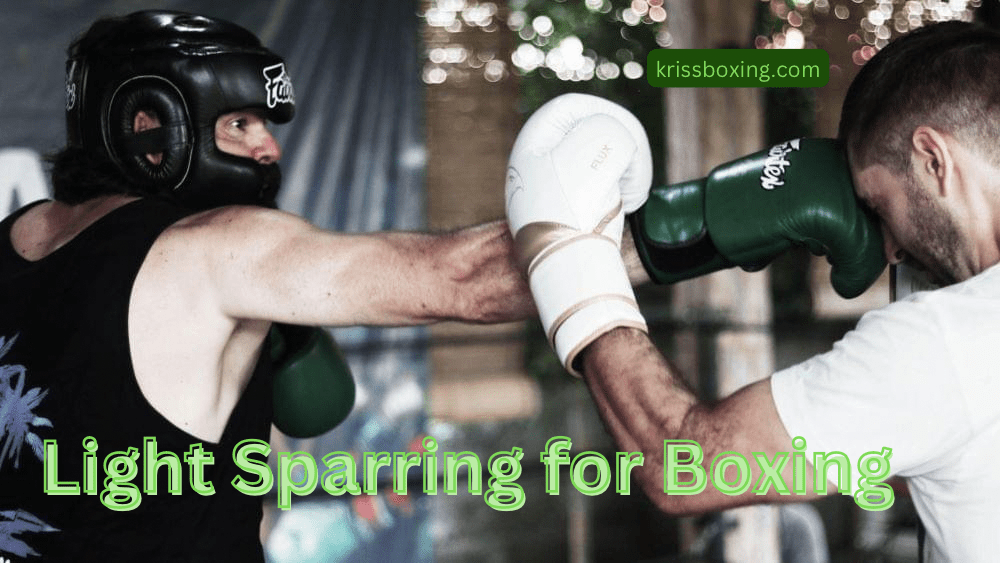Sparring is also used in boxing and is considered an integral part of practice since it allows the trainees to practice their moves as well as their timing and mental strength.
However, only some sessions require that the fighters go head to head or give it their all in every drill. ”Light sparring, which is frequently ignored, can bring out something that rigs can provide that is undiscovered and essential for a boxer.
This article seeks to present when and how light sparring is most appropriate to be of most value to a boxer but not result in harm.
What is Light Sparring?
Light sparring is also a type of light contact sparring where the strength and force that each of the boxers applies in the punches are moderated. Instead of applying force, one tries to be as accurate as possible and act at the right moment as well as make the right decisions.
This enables the boxers to go through their paces in conditions that are almost or equally as real with the full contact sparring sessions but with less severity of injuries.
Benefits of Light Sparring
- Skill Development: This kind of fight offers an advantage in that the contender can test several moves and sequences that are almost real fight situations.
- Improved Defense: With less impact as felt in punches, the fighters can concentrate on their footwork as well as in evasion, guarding, or even deflecting.
- Enhanced Timing and Reflexes: This explains why one has to ‘slow down’ the speed of light sparring since this is a good way of developing your time and reflexes which are very vital in boxing.
- Mental Focus: Freestyle allows boxers to sharpen their minds and be more alert during a bout therefore increasing their chances of coming up with strategies.
- Reduced Risk of Injury: Reducing the strength that punches possess Which in turn reduces the chances of getting knocked down unconscious, getting a concussion, getting a cut, or getting a bruise.
When to Use Light Sparring
- Learning New Techniques: While introducing such techniques or when using a variation of the previously used technique, light sparring is desirable since it aims at developing the skills to the application of the techniques without necessarily employing the actual striking techniques.
- Recovery Sessions: To that light sparring is used to keep busy, especially after strict training sessions or fights.
- Warm-Up: Light sparring can also be highly effective as a preparatory stage before other serious sparring or training sessions in a way that will put the boxers in the right disposition.
- Skill Maintenance: Essentially in the phases or the break between training sessions, light sparring is very useful in as much as it conserves energy and body strength which would otherwise be used in normal sparring.
- Conditioning Drills: When conditioning try to include some light sparring to have high cardiovascular endurance and at the same time have full concentration on technique.
How to Successfully Execute Light Sparring
- Communicate with Your Partner: Before starting the spar assure your partner on the intensity level that is safe for you but not too easy. Choose the primary goals of the session, it could be defense, footwork, or particular drills.
- Focus on Technique: Prefer accuracy to power, pacify to power, power formula. This is the right time to fine-tune events and make sure every movement is done right.
- Stay Relaxed: Avoid tension in the muscles and stiffness in the joints: always be graceful. This assists in control and is undesirable stress-provoking as a result.
- Use Varied Scenarios: Excellent fighters should practice in different fight positions beside the ropes and in the middle of the ring.
- Review and Reflect: It is therefore advised that after each light sparring session, the participant should take his/her time to analyze the conduct of the fight. In a friendly conversation with your coach or your partner focus on what was good and what could be better.
Frequently Asked Questions
How often should I incorporate light sparring into my training?
You should include light sparring into your training at least once or twice a week. This frequency enables a person to rehearse the techniques often but it does not overload the body.
Can light sparring replace full-contact sparring?
No, let me contradict myself light sparring should be the full complement of full-contact sparring not instead of it. Every kind of sparring training has advantages and can be incorporated into a training program.
What gear should I use for light sparring?
For light contact practice, the students should still wear their protection gear which includes the helmet, mouthpieces, and gloves for sparring. This reduces the risks for the fighters and generally assists in developing the tradition of practicing using protective gear while sparring.
How can I ensure my partner and I are on the same page regarding intensity?
Communication is key. Boxers must be informed about the training objectives and the chosen working pace at the beginning of the session. From time to time monitor from distance the session as you agreed with your partner to avoid going over the set boundaries
Is light sparring beneficial for beginners?
Yes, it is important, especially for those who are newbies in the use of the part and for light touch moments. It helps them to adapt to the tactics of contesting, gain confidence, and learn methods of fighting without the feeling of being injured.
Conclusion
Interestingly, practices like light brawls have great benefits that range from increasing the technical proficiency of a boxer to decreasing the likelihood of getting an injury to the boxer.
It can be suggested that inculcating light sparring sessions into practice have multiple benefits such as skill development, strengthening the defensive aspects, keeping oneself physically and mentally fit, and lastly, reducing the probability of getting an injury.
Do not forget to warm up with your partners, and avoid strong impacts during the sparring, and in case of the light sparring, I meant, it’s a good chance to learn new things as a boxer. Light sparring can easily be explained to mean that even if you are a novice or even an experienced fighter, light sparring is always of merit to you as a fighter and will enhance how you fight in the ring in equal measure.


